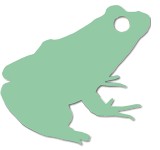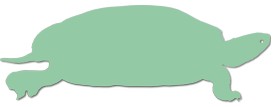Herp Bits:
The Northern Prairie Skink can lose its tail, a process called autotomy, to distract predators attacking it.
The disembodied tail will wriggle for several minutes while the skink dashes away to safety.
Basic Biology of Manitoba's Herps
Manitoba's herps fit into several discreet groups: frogs & toads, salamanders, snakes, lizards and turtles. Some common aspects of the biology of each group are presented here. In the individual species accounts only unique or characteristic aspects are given. The individual species accounts are intended only as an introduction to each species, focusing on species identification and current status.
Geographic Ranges of Species
Information on the geographic ranges of North American herps (see Resources) varies considerably for most species. We are STILL sifting through the maps and accounts provided by all the "experts" out there. The ranges of the species presented here, information and maps, should be considered rough estimates only. As better data becomes available (that's the purpose of this project, after all!), more detailed maps of the ranges of these species in Manitoba will be prepared.
Taxonomic Changes
There have been lots of changes to the names and classification of Manitoba's herps in recent years. DNA analysis has become the standard for determining taxonomic relationships these days, and it often results in surprising findings regarding relatedness (or un-relatedness) of species. New species are being recognized on the basis of genetic distinctness, others are being re-classed as subspecies, entire genera are being renamed or classed in new or different families. We've pointed out numerous instances of these in the MHA. This can be somewhat confusing when you refer to other, older resource materials. In many cases it may be best to look up species both by their scientific names and their common names, just to be sure you are dealing with the right animal. We'll try to keep things as up-to-date as possible, but taxonomists are a busy bunch; there will undoubtedly be more changes coming.
Frogs and Toads (Subclass Anura - tailless amphibians)
 Sexual Dimorphism - Adult female frogs and toads are usually substantially larger than males, often up to twice the weight. The tympanum (ear drum) of males will be much larger than in females. Some species may differ in colouration between the sexes, but there are few other reliable characteristics to distinguish the sexes externally.
Sexual Dimorphism - Adult female frogs and toads are usually substantially larger than males, often up to twice the weight. The tympanum (ear drum) of males will be much larger than in females. Some species may differ in colouration between the sexes, but there are few other reliable characteristics to distinguish the sexes externally.
Life Cycle - Males call near water bodies to attract females to mate with them. The call of each species is unique and is often the best, and sometimes the only way to distinguish species. (Learning to recognize the calls of all Manitoba's species is an important step to participating in the MHA.) To mate a male climbs onto the back of a female and clasps his forearms tightly around the female. While he maintains his grip the pair are said to be in "amplexus". The female will move to a desired location in the water body to lay her eggs. When she releases her eggs the male releases his sperm, fertilizing the eggs in the water. The eggs are surrounded in jelly-like proteins that absorb water and swell up to protect the eggs and hold them together. Egg development is temperature dependent, larvae* (tadpoles) may hatch in as little as 2 or 3 days or may take up to 2 weeks. With the exception of Green and Mink Frogs all our species prefer to breed in smaller, fish-free water bodies.
[* When a young animal progresses through distinct stages before changing to adult form it is called a larva. Larva (plural larvae) is now the more accepted term for the developing young of amphibians, but tadpole is still a common term.]
Most frogs and toads require about two years to grow large enough to be sexually mature. The life spans of frogs and toads in the wild are not well documented, but most species can probably live at least 5 -10 years. Captive Toads have lived for as much as 40 years.
Habits/Behaviours - Frogs and toads are primarily nocturnal. They do most of their foraging at night and try to remain hidden during daylight hours. However, they will eat whenever opportunities arise. During spring and fall when night time temperatures are cool they may be more active during the day.
Diet - Adult frogs and toads conform to the rule: "if it moves and will fit in the mouth, eat it!" Their diet will consist of whatever invertebrates (mostly insects) and even small vertebrates (small frogs or snakes, even baby mice or birds) found in the habitat where they live. Larvae eat many kinds of organic matter found in the water: algae, live and dead plants, dead animal matter, etc. Cannibalism is not uncommon, larger larvae may actively kill and eat smaller ones in some species.
Overwintering - There are three basic overwintering strategies used by Manitoba's frogs and toads. One group spends winter in water bodies which don't freeze to the bottom (Green, Mink and Leopard frogs). The adults, and larvae in the case of Green and Mink frogs, rest on the bottom and absorb oxygen through their skin.
All our toad species overwinter on land, but below the frost line. They burrow down in loose soils or may make use of abandoned animal burrows or other holes to remain at temperatures above the freezing point. Toads and the Green, Mink and Leopard frogs cannot survive freezing.
The third strategy employed by all our treefrogs plus the Wood frog is to overwinter on land at the ground surface and survive freezing. These species flood their body tissues with glucose which acts as an anti-freeze allowing them to survive temperatures down to about -10 C. Under the insulating cover of ground vegetation and snow, temperatures near the ground surface rarely dip below this point.
Overwintering strategies play a major role in where a species can live. Those which rely on permanent water to overwinter cannot live far from larger water bodies. Those which burrow below the frost line must have deep loose soils to overwinter, but along with those that are freeze tolerant they can inhabit areas with smaller or even temporary water bodies for breeding.
Salamanders (Subclass Urodela - tailed amphibians)
 Sexual Dimorphism - Males can usually be identified by swelling around the cloaca, especially during the breeding season. Females will usually be larger and thicker bodied than males. But it is often difficult to determine the sex of salamanders.
Sexual Dimorphism - Males can usually be identified by swelling around the cloaca, especially during the breeding season. Females will usually be larger and thicker bodied than males. But it is often difficult to determine the sex of salamanders.
Life Cycle - Manitoba's terrestrial salamanders, the three Ambystomatid species, breed in small ponds. Adults move to ponds in early spring, often just after the ice melts. Males court females by displaying to them and releasing pheromones. A male will deposit a packet of sperm, a spermatophore, on the bottom of the pond and a receptive female will move over the spermatophore and take it up into her cloaca. Her eggs are fertilized internally, then she lays batches of jelly-coated eggs attached to stalks of submerged vegetation. The eggs develop for 3-4 weeks, depending on water temperatures. Larvae are well developed when they hatch with functioning eyes, mouth, external gills and tail fin. They can grow to sufficient size to transform to terrestrial adults in 8-10 weeks.
The life spans of salamanders are not well documented, but most can probably live more than 10 years. Captive Tiger Salamanders have lived for 20 years.
Habits/Behaviours - Terrestrial salamanders are mainly nocturnal, but never stray far from cover. They forage under forest litter or in other dense ground covers. They readily tunnel through soft soils or humus, retreating to tunnels or burrows during the day. Mudpuppies are largely nocturnal, too, and seldom move far from cover beneath submerged rocks or logs.
Diet - Adult and larval salamanders are predatory, eating whatever invertebrates or small vertebrates they encounter. Whatever moves and fits in the mouth is considered food. Larvae hunt for tiny aquatic animals as soon as they hatch and progress to larger prey as they grow. Cannibalism is common in larval salamanders. Larger individuals readily devour smaller ones.
Salamanders are less dependent on the motion of their prey to stimulate feeding than are frogs and toads. They can use scent/taste to locate suitable food items and will eat slow moving animals such as snails and some carrion.
Adult mudpuppies are aggressive predators and eat small fish and other amphibians. They are occasionally caught by people fishing with baited hooks.
Overwintering - Terrestrial salamanders spend winter below the frost line. They burrow down in loose soils or make use of animal burrows or other holes. They can, however, be active at body temperatures very close to freezing, and may remain active to a degree in their burrows or other available habitats throughout winter. Immature larvae or neotenic adults can overwinter in large ponds that do not freeze to the bottom. Mudpuppies spend their lives in permanent water bodies. They are known to be active all winter and are occasionally caught by ice-fishers. None of Manitoba's salamanders can survive freezing.
Snakes
 Sexual Dimorphism - In general, female snakes are larger and thicker bodied than males. At the junction of the body and tail, right at the cloaca, the tail of a female will taper noticeably, while in a male the taper is gradual, often unnoticeable.
Sexual Dimorphism - In general, female snakes are larger and thicker bodied than males. At the junction of the body and tail, right at the cloaca, the tail of a female will taper noticeably, while in a male the taper is gradual, often unnoticeable.
Life Cycle - All our snakes mate in spring shortly after emerging from hibernation. Females emit pheromones that attract males. Males court a female by nudging her or rubbing along her back. When the female is receptive she allows a male to insert his hemipenes and deposit sperm. Her eggs will be fertilized internally. Some species lay eggs in nests under cover or in shallow burrows. Some species retain the eggs in the oviduct and give birth to live young (ovovivipary). They do not nourish the developing young in the eggs with a placenta like mammals do, rather the egg is just kept inside the female's body. Garter Snakes are viviparous and do nourish the young from a placenta.
Life spans of Manitoba's snakes in the wild are not well documented, but most can likely live for 5 - 10 years. Captive Garter Snakes have lived for 14 years.
Habits/Behaviours - All our snakes are primarily diurnal. They need to be able to raise their body temperatures to a certain level to be active and digest food properly. Individuals will bask in the sun to warm themselves on cool mornings before foraging. In warm weather in mid-summer snakes may be active in evenings or even at night.
Diet -Snakes have varying diets, but all hunt and catch prey in a similar manner. They have excellent olfactory senses and localize prey by scent, even following prey by a scent trail. Once they are close to prey vision becomes more important and they will react to movement of their prey. Our snakes do not have any means of killing prey rapidly, they are not venomous (with the possible exception of the Hognose Snake) or constrictors. They simply grab prey with their jaws and hold on. They work their jaws, filled with backward pointing recurved teeth, over the prey item until it can be swallowed whole and alive. Many snakes are specialized in being able to detoxify poisons or noxious chemicals in their prey. Toads and salamanders have toxins in their skin that protect them from being eaten by many animals, but snakes have evolved to deal with these poisons.
Overwintering - All Manitoba's snakes spend winter below the frost line. None can survive freezing. They make use of caves, animal burrows, ant nests or human dwellings to make their way below the frost line. Snakes are thought to remain inactive over winter, but little research has been done on overwintering levels of activity.
Turtles
 Sexual Dimorphism - Females are larger than males, except in the Snapping Turtles where males tend to be larger. In both our turtle species the tails of males are longer and narrower at the base than females. The plastron (lower shell) of males is more concave and the cloaca of males extends further from the shell than in females. These are adaptations to allow the male to mount a female and mate. Males have longer front claws than females, though this is less obvious in Snapping Turtles.
Sexual Dimorphism - Females are larger than males, except in the Snapping Turtles where males tend to be larger. In both our turtle species the tails of males are longer and narrower at the base than females. The plastron (lower shell) of males is more concave and the cloaca of males extends further from the shell than in females. These are adaptations to allow the male to mount a female and mate. Males have longer front claws than females, though this is less obvious in Snapping Turtles.
Life Cycle - Turtles mate in spring. Males pursue and court females, often swimming backwards in front of the female and using their long front claws to "tickle" the female. Males mount females from behind and fertilization is internal. Eggs are laid in nests dug by the females in soft earth or sand, often considerable distances from water. Nests are abandoned by the females and young hatch out in autumn.
Turtles are long-lived animals. Life spans in the wild are not well recorded for both our species, but 30 - 50 years may not be unusual.
Diet - See individual species accounts.
Habits/Behaviours - Turtles are primarily diurnal. When waters are cool they are dependent on basking to raise their body temperatures so they can forage effectively and digest their food efficiently. When waters are warm in summer they are less dependent on basking and are probably active over longer periods during the day and even at night.
Overwintering - Both our turtles overwinter on the bottom of permanent water bodies. They remain inactive below the ice, absorbing oxygen through their skin.
Skinks
 Biology of Skinks -
Refer to the SOS website.
Biology of Skinks -
Refer to the SOS website.
You can help support the continuing operations of this citizen-science project. Every contribution makes a difference! |